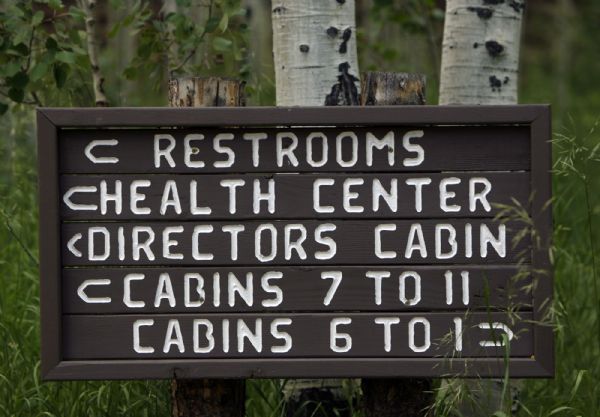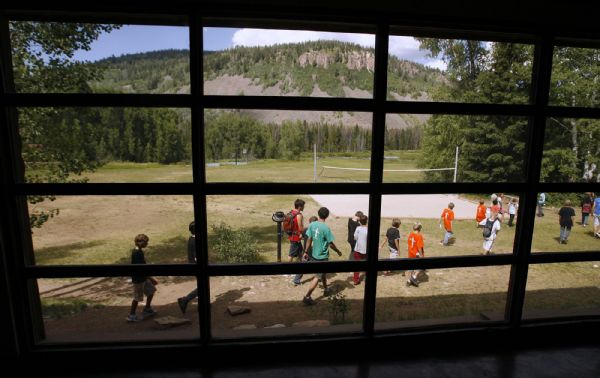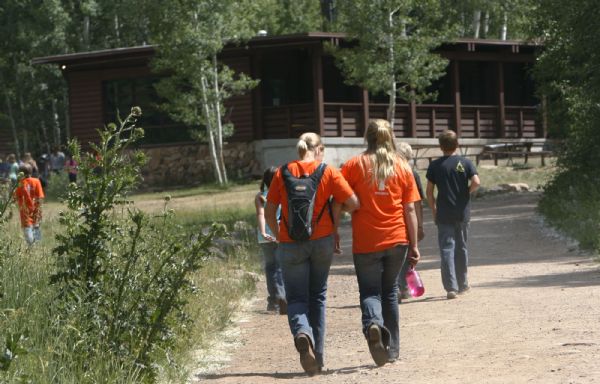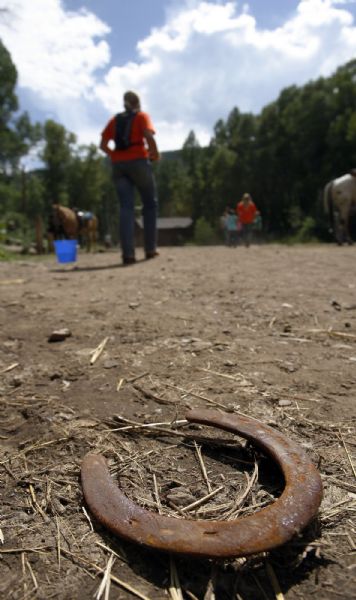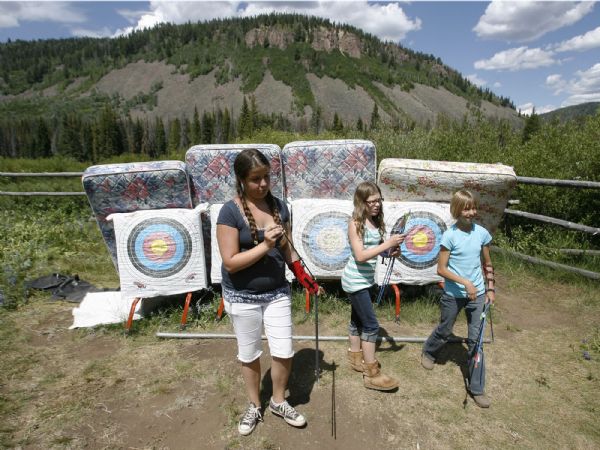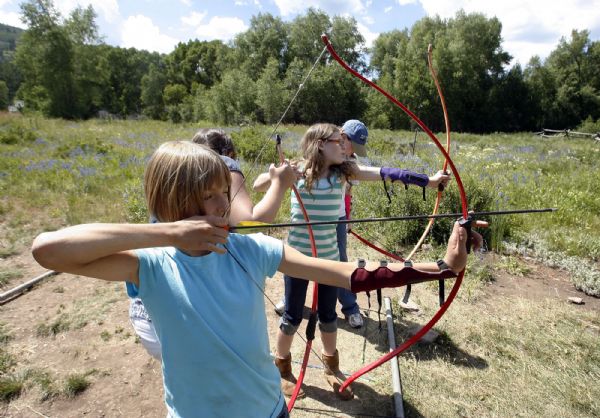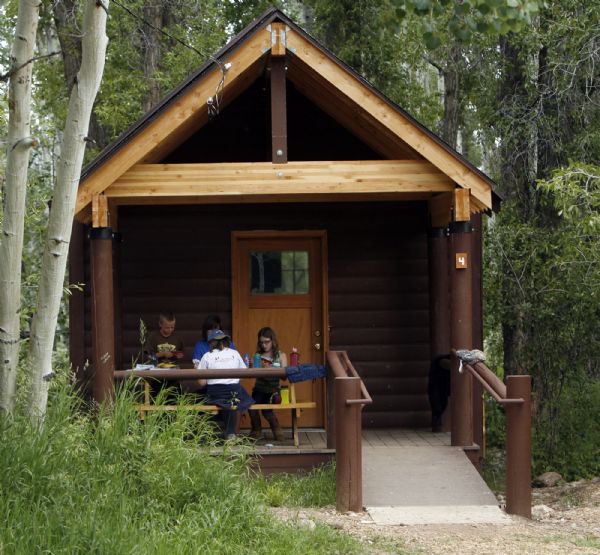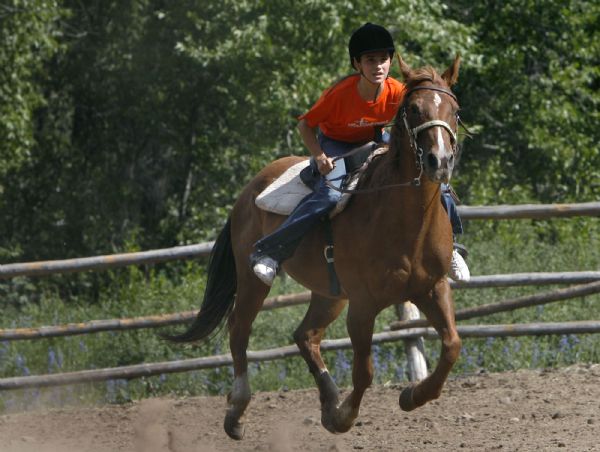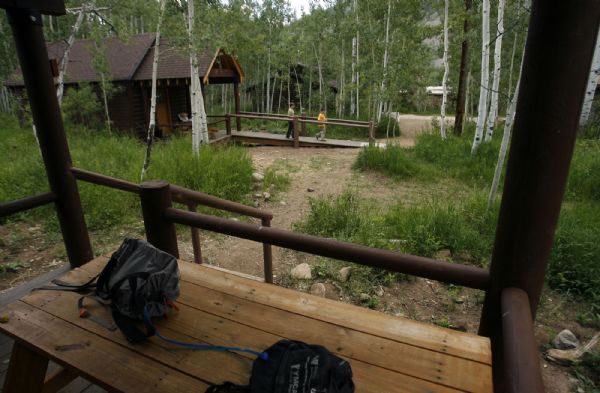This is an archived article that was published on sltrib.com in 2009, and information in the article may be outdated. It is provided only for personal research purposes and may not be reprinted.
Kamas » The kids tie-dying shirts, playing ball or tying boondoggle at venerable Camp Roger on this bright summer day might not know much about the history of the place they are calling home for a week.
But for almost every year since it opened with week-long camps for boys in 1948, the former site of a Civilian Conservation Corps camp 14.5 miles east of Kamas has been hosting teenagers who often come as strangers and leave as friends.
"It's awesome!" exclaimed 12-year-old Mt. Jordan Middle School student Allie Korologos. "You don't feel like you have to think about things to do. It's exciting... The best is the dance. We had a Harry Potter theme dinner. I made a wand."
For 12-year-old Mercedes Paige of Salt Lake City, counselors make the experience inviting and fun. That's especially true this year as camp counselors come from all over the world, including England, Scotland, Australia and Hungary.
Amy Henry, director of the co-ed camp that every year hosts nearly 600 campers between the ages of seven and 17, said each counselor brings a different set of skills that add to such traditional camp activities as archery, horseback riding, mountain biking, arts and crafts, swimming, orienteering and nature education.
For example, Catherine Meidell of Reno, a sophomore at Utah State University who is majoring in print journalism, teaches kick boxing, pilates, photography, creative writing and dance to campers.
"It was a good summer experience with memories I could take with me afterwords. I like sharing something I love with the kids," she said.
Camp Roger is the only YMCA facility in Utah. Camp founder and namesake Roger Freund had the government transfer the old CCC camp to YMCA ownership and then obtained a special use permit from the U.S. Forest Service to operate it as a kids camp. When the camp went co-ed, it made all the difference to kids like Marie Hynes Schulthies of Salt Lake City.
"I think the most important message is it was such an opportunity for women," said Schulthies, who attended camp with her sister and cousins in the late 1950s. "It was the start of the evolution that women could do outdoors sports as well as men.
The opportunity to learn how to shoot and camp was "a confidence builder," she added. "When you got out of there and you could take of yourself in the middle of the woods, that told you you could take care of yourself just about anywhere."
Getting a facelift » Three original CCC-era buildings -- the maintenance garage, barn and tack shed -- remain on the site, which now includes a lodge that houses the kitchen and dining hall; a number of one-room cabins equipped with bunk beds; a covered porch with picnic tables; bath houses; a health center; program buildings; a beaver pond; a corral with 20 horses; an outdoor amphitheater with a campfire circle; and numerous nearby hiking trails.
The camp struggled for a few years and for a time was operated jointly by the University of Utah and YMCA. But there's been an uptick in interest in recent years along with an upgrade of the facilities. Executive director Rich West said the YMCA board decided in 2006 that sprucing up Camp Roger, the group's signature facility in Utah, would help raise the organization's profile. With help from a $250,000 grant from the George and Dolores Eccles Foundation, the YMCA spent $700,000 recently to remodel the director's cabin, lodge, kitchen and sleeping cabins.
Where many of the structures once appeared run down, the place now has a new feel.
The modern facilities are a far cry from the camp's first year in 1948, when Fruend got the Salt Lake Rotary Club to donate tents, cots, cooking utensils and dishes for two one-week camps open to any boy nine years of age and up.
In 1948, the cost of going to camp was $28 -- with an extra $1 for health insurance. These days, the YMCA uses a four-tiered pricing structure. The actual cost of a resident camp is $490 a week but, depending on a family's circumstances or whether they are sending multiple kids, that can drop to $440 or $390. And some campers receive scholarships as well.
"It's an honor system," said Henry. "It's hard being a judge [of what a family can afford.] People know their budget better than we do."
Henry said there is an emphasis on some of the themes promoted by the national YMCA with symbolic activities designed to teach core values of caring, honesty, respect and responsibility.
The camp experience » Henry and her staff of about 30 work hard to keep kids busy with individual and group activities. Night-time activities can include open campfires, sing a longs, story telling, scavenger hunts, and funny auctions. There's always a dance and a theme dinner. One night, campers cook "hobo dinners" in tinfoil over a campfire and sleep under the stars. Parents are invited to the closing dinner on Friday.
"Parents get a feel for what a campers' experience has been through the week," said West. "It gives parents a chance to really see and experience other campers."
Henry and West said that while fun activities draw kids to camp, most remember more about the friends and relationships they had, with activities used to help that process. And many Tribune readers offered memories of their Camp Roger experiences.
"The day I most remember we set out to ride horses -- my main reason for wanting to go there -- and because my best friend had horses that I had ridden before, I got the crazy horse aptly named Diablo," wrote Cinde Law of Salt Lake City, who went to camp in 1965. "As we took off on our ride up the mountain, he decided he didn't want anyone riding on his back so he walked me right down into the creek and proceeded to rear up until he dumped me off. After I was fished out of the creek, I got right back on him and we had a great day."
Janice Klein of Draper was a counselor at the camp in the mid-60s who recalled taking her charges on a hike. The day began sunny but clouds darkened the sky and it began to snow as daylight waned.
"This slowed down our pace considerably and took us longer than expected to make our way back," she recalled. "Some of the children began to get worried. So, to keep our spirits up, we began to sing Christmas songs...We quickly made a big fire in the lodge, roasted hot dogs and smores and celebrated Christmas on July 7. We even decorated a Christmas tree."
wharton@sltrib.com" Target="_BLANK">wharton@sltrib.com
Camp Roger is 14.5 miles east of Kamas just off Utah Highway 150 -- the Mirror Lake Highway. The full cost for a week at camp is $490, although scholarships and discounts are available. A few spots are still available for this season, which wraps up on Aug. 15. For more information, visit http://www.YMCAsaltlake.org" Target="_BLANK">http://www.YMCAsaltlake.org or call 801-466-6299.
We asked readers to share their memories of Camp Roger. Here is a sampling of what they sent us, edited for length:
The summer of love
In the summer of 1957, the Salt Lake YMCA recruited staff for Camp Roger in Salt Lake City. A student at Westminster College and a teacher from Salt Lake City went to work in the kitchen at Camp Roger as an assistant cook and dining room superintendent. These two were attracted to each other and were together a lot during those two summers. They slid down Mt. Baldy glacier on rubber aprons, road horseback over the mountain to Duchesne, walked along the Provo River and cooked for over 150 campers every meal and helped with counseling campers when the regular cabin counselors were on a required day off. They got the campfires together and one of them sang the Indian Love call many times during those two summers.
This couple, Lois Herrmann and Robert (Archie) Archuleta, were married in November of 1958, and in November of 2008 celebrated their 50th wedding anniversary.
Camp Roger holds that very special spot in our hearts.
-- Lois and Archie Archuleta, Salt Lake City
Strolling down Memory Lane
I started going to Camp Roger in 1968. I have photos and a lot of stories -- some you might not want to print.
Guess my best memories are of the wranglers, John Stroud and Dennis Ashtroth! I am smiling very big right now. Riding my favorite buckskin horse "Tippy." The wonderful "cooks" and the great meals they prepared for us three times a day. Food fights -- washing dishes in the galvanized tubs. Announcements after dinner and the song that went along with it.
Archery, row boats, 22 and BB shooting, arts and crafts. I still have boonedoggle I made. I remember a two day hiking trip to Ruth Lake when it rained the entire time. Everything was soaked, the old Coleman sleeping bags were wet, and added an additional 20 pounds to the backpack. UGH! If we were there for two weeks, we usually got to go to Kamas on the weekend. The first stop was Dick's Drive-In. We use to have our own special drink --blueberry Fresca. Sounds gross, but it was the best. Some years later, I was camping at Mirror Lake with my family. We went into Dick's and I ask for a blueberry Fresca. The young lady behind the counter looked at me like I was nuts. However, from the back of the grill area, an older lady came up front and smiled and said "You must be an old Camp Roger kid." She fixed the special potion as she probably did 30 years earlier. It tasted like childhood. I have never forgotten it.
-- Lea Ann Southwick, Salt Lake City
Earning their stripes
The friends, the campfires, shooting a bow, arts and crafts -- it was all great.
The final night of camp they would get together and make up skits to show to all the different campers and groups. I can still remember us marching to the stage, holding chairs above our heads, bandanas over our faces like bandits, and singing the marching song from the movie "Stripes." We then did a song and dance number that finished with us upside down on the chairs and faces painted on our chins, singing the final verses to our marching song.
I send my kids to Camp Roger now, so they might be able to get some of those memories too.
-- Eric Wilson, Salt Lake City
Sing, sing a song
During the summer of 1956 I was a "camp counselor" at the YMCA camp which later was renamed Camp Roger. Roger Fruend was called Dad Fruend and he was a great driver in the camp, doing every thing from filling in as a camp cook to being the primary construction crew in the building of a new cabin for the young guys to use.
One of several best memories of camp days was when a New Man was shipped in by the national YMCA to help with the operation of the camp. He was a great guy and worked very hard but he did have a few different ideas of what should be going on. Before his arrival all meals were time for "singing" of camp songs by the kids. First order of business for counselors was to teach the kids the songs, but the New Guy did not think singing at meal time was a good idea and on about his second Tuesday of being at camp, he asked at our daily pre-lunch staff meeting to stop having the kids sing at meals. This stayed in effect until lunch on Saturday, when Dad Fruend got up and announced, without even knowing about the new guy's idea, that the thing he missed at breakfast that morning was a good round of camp songs. Dad then led everyone in a medley of all the camp songs we ever knew. To my knowledge, the singing of camps songs stayed for long after that time.
-- Steve Brown, Kamas
Clothing optional
attended a week at Camp Roger 30 years ago. It was a life changing experience for me. I was forced to come out of my shell with the six other boys that I shared a cabin with. We gave each other nicknames. Mine was "Johnny Appleweed."
We took an overnight hike into the woods and all the counselors brought for us to eat was marshmallows and big cans of orange juice that we passed around and shared. I remember two of the counselors were foul mouthed when talking to each other and when they didn't think we kids were listening and one of them spit in my hair on the bus. I heard them talking about hiring hookers and had to ask my parents what a hooker was when I got back into town. We went deep into the woods looking for another leader and were turned back when we discovered that he was chopping wood buck naked.
-- John Dilley, West Jordan
Turning night into day
I was there back in the summer of 1964. I remember I was 8 1/2 years old. At that time, the age limit was 9 years old, but because my brother was 11 1/2, somehow my parents talked the camp staff into letting me go along.
Each morning we had to clean and sweep our cabin and the cabin that was the cleanest each day by the end of the week received an award. I do not remember what it was, but I know our cabin did win the award. The food was great, but I distinctly remember the oatmeal was real bad. It was thicker than wall paste.
It must have been the last night at camp when we had a big bonfire. I can still see the camp directors carrying around several gallon milk jugs full of gas to put on the wood for the camp fire. As I watched the leaders pour gas on the wood, I thought to myself, this is going to be a real hot fire. I remember when they threw the match on the fire, how quickly the wood flamed up. It turned the night into day, instantly. Some of the leaders threw some fireworks into the fire, which made it a real exciting night.
-- Cory Rushton


